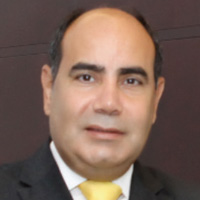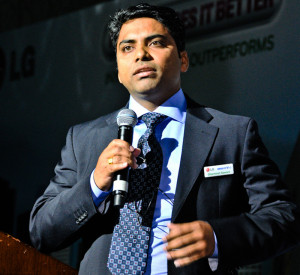Can the market for VRFs continue to thrive in the GCC region? Opinions by a few industry players help understand the perceived status quo.

George Berbari
George Berbari, CEO of DC PRO Engineering, in 2015 reprimanded the Variable Refrigerant Flow (VRF) industry for not doing enough to build confidence in the technology. He was voicing his opinion at the 3rd Annual Middle East Variable Refrigerants Flow Conference, produced by CPI Industry, publishers of Climate Control Middle East magazine. This definitely ruffled a few feathers at the conference, especially of those from the VRF fraternity.
Berbari’s complaint was particularly about the lack of availability of operational data when it came to VRF systems. To this, Toshiba, one of the manufacturers, represented by AHI Carrier, responded by coming back with real-time operational data. Moan Abraham, General Manager (Air- Conditioners), Hisense Middle East, too, defending the sector, remarked at the conference: “I think most of the VRF manufacturers have IT-based control systems, which are very up-to-date. And they have software to record the data on a real-time basis.”
With the coming of VRFs, CHW systems have seen an erosion of market share
Despite Berbari’s reservations, the fact of the matter is, the VRF market is worth approximately USD 10 billion, globally. In the Middle East, several consultants and building owners are turning towards VRF technology due to its purported attributes like flexibility, energy efficiency and a compact footprint, due to its modularity, among others. On their part, HVAC manufacturers in the region have intensified their drive to promote VRFs, highlighting the same attributes.

Moan Abraham, General Manager (Air Conditioners), Hisense Middle East
“The next big thing is VRF,” Abraham claims. “Today, there are pockets of it [VRF systems] in Japan, Korea and China. We have got a very good channel, business-wise [in the UAE].” He acknowledges that the UAE is not a benchmark for VRFs yet, and that a change in perception is needed.
Geunwoo Park, General Manager at LG Electronics, says, “New developers, like IGO and Diamond Developers, who want to promote real estate value, prefer to go from one-to-one systems to more organised systems like VRFs.” He, however, believes that there was a 10-15% increase in sales in 2015, and that this year they expect it to be 5-10%.

Dharmesh Sawant
Speaking specifically about the GCC market, Dharmesh Sawant says: “Now, there is very good awareness on VRF systems among consultants. Earlier, only LG, Mitsubishi and Daikin were talking about VRF systems; now, more players are talking.” Sawant, Senior Manager – B2B AC at LG Electronics, believes that in terms of total costs – installation cost of the unit, and the like – VRFs are 5-10% more expensive than ducted- splits. However, he believes that there are OPEX advantages on using VRFs. Park adds to this by saying that earlier, VRFs were considered ideal only for villas, but now, they are used even in apartments.
The bone of contention
So wherein lies the real issue, one might ask. Abraham thinks that some people have accepted VRFs and some have not. The problem, he says, is that consultants are earning less money from VRFs than they would from chilled water (CHW) systems. He explains: “Awareness is there, acceptance is there but the issue is affordability. It is not a low-hanging fruit. Manufacturers of VRFs need to make it affordable, else the market size for VRFs will remain small.”
The UAE is not a benchmark for VRFs yet. A change in perception is needed
Another issue in the GCC region is the lack of skilled installers. “How are installers in Turkey able to install VRFs from the back of their trucks?” asks Abraham, and answers: “Such is their skills sets. Those guys are not engineers; they were split [system] installers. Today, they are VRF installers. So, GCC [region] needs better installers.”

Zakir Ahmed, Managing Director at NIA Limited
Industry expert, Zakir Ahmed, Managing Director at NIA Limited, says that the development of VRF is reaching its pinnacle, and adds: “There is nothing more VRF can improvise upon. It is energy saving. AHRI has clearly said VRF gives 35% more energy efficiency compared to one-to-one systems. The next level of VRF is about flexibility and absolute control by zones – the combination of zonal control and the benefit of using part- load.”
Ahmed thinks that there exists a direct conflict for market share between CHW systems and VRFs. “With the coming of VRFs, CHW systems have seen an erosion of market share, and chiller manufacturers have seen businesses moving away in Japan and other mature markets,” he points out. “So CHW players clearly recognised the strategic advantages of zone control and 35% more energy efficiency.”

Syed Jafar Imam, Senior Regional Manager – RLC (Middle East and Africa) at AHI Carrier
The next step
Syed Jafar Imam, Senior Regional Manager – RLC (Middle East and Africa), at AHI Carrier, believes that, as manufacturers, they no longer need to defend VRF systems anymore, as their worth has already been established. “We need to focus more on how VRF systems can be incorporated in various systems,” he stresses. Pointing to another marketing strategy manufacturers could adopt, he adds that it would be a good idea to get endorsements from developers implementing VRF systems, through presentations.
[div class=”row”]
[div class=”col-md-10 col-md-offset-1 content-sidebox”]
Quotes to note
“In Japan, where it was invented around 35 years ago, we have already come so far in achieving energy efficiency through the use of inverter systems. So inverter systems, as well as the focus on part-load performance, will definitely spread to more markets.
“The more that people become aware of the benefits of the VRF system, the more they use it. And the benefits are for the user, particularly in terms of comfort. Indoor temperature is stable and always close to the set-point – and power is used only when needed. So you have the perfect comfort with the lowest possible cost of energy, with the flexibility of installation in buildings.”
Ryouji Sanou, President of Daikin Middle East and Africa, when Climate Control Middle East asked him about the factors behind the growing interest in VRF technology
“As for its [VRFs] link to 2020, I think that VRF is going to become a very important technology, and will be incorporated into the entire Expo 2020 infrastructure.”
Vir S Advani, Executive Director at Blue Star, when Climate Control Middle East asked him about VRFs vis-à-vis EXPO 2020
“Market trends around the world are driving VRF. In North African countries, VRF makes up majority of the HVAC market. The same is true in Turkey, Iran and Pakistan. In India, VRF is also a big deal, and in the GCC [region], 10-15% of the market is now being specified as VRF. So VRF is no longer a choice but a necessity for every single HVAC company. They all have to embrace VRF; otherwise, they could easily be out of the market in the coming five years.”
Fady Nassar, Director of Unitary Business at SKM Air Conditioning, when Climate Control Middle East spoke with him during a seminar his company organised in January
[end-div]
[end-div]
Copyright © 2006-2025 - CPI Industry. All rights reserved.